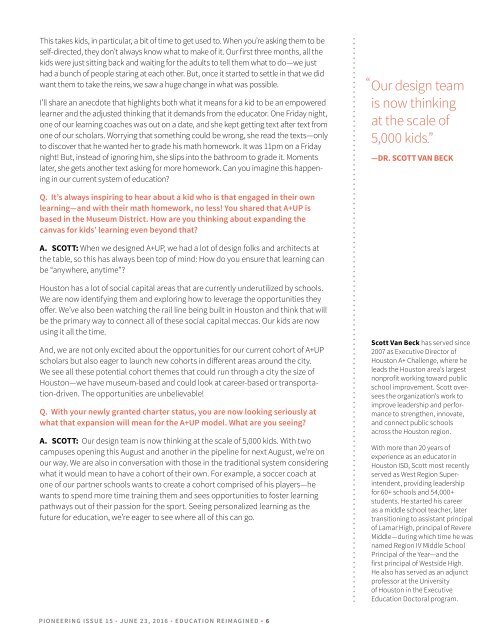pioneering
click?u=4207a5b103c6af0fa46c0ffd7&id=9c78fd7430&e=222d7da559
click?u=4207a5b103c6af0fa46c0ffd7&id=9c78fd7430&e=222d7da559
Create successful ePaper yourself
Turn your PDF publications into a flip-book with our unique Google optimized e-Paper software.
This takes kids, in particular, a bit of time to get used to. When you’re asking them to be<br />
self-directed, they don’t always know what to make of it. Our first three months, all the<br />
kids were just sitting back and waiting for the adults to tell them what to do—we just<br />
had a bunch of people staring at each other. But, once it started to settle in that we did<br />
want them to take the reins, we saw a huge change in what was possible.<br />
I’ll share an anecdote that highlights both what it means for a kid to be an empowered<br />
learner and the adjusted thinking that it demands from the educator. One Friday night,<br />
one of our learning coaches was out on a date, and she kept getting text after text from<br />
one of our scholars. Worrying that something could be wrong, she read the texts—only<br />
to discover that he wanted her to grade his math homework. It was 11pm on a Friday<br />
night! But, instead of ignoring him, she slips into the bathroom to grade it. Moments<br />
later, she gets another text asking for more homework. Can you imagine this happening<br />
in our current system of education?<br />
“ Our design team<br />
is now thinking<br />
at the scale of<br />
5,000 kids.”<br />
—DR. SCOTT VAN BECK<br />
Q. It’s always inspiring to hear about a kid who is that engaged in their own<br />
learning—and with their math homework, no less! You shared that A+UP is<br />
based in the Museum District. How are you thinking about expanding the<br />
canvas for kids’ learning even beyond that?<br />
A. SCOTT: When we designed A+UP, we had a lot of design folks and architects at<br />
the table, so this has always been top of mind: How do you ensure that learning can<br />
be “anywhere, anytime”?<br />
Houston has a lot of social capital areas that are currently underutilized by schools.<br />
We are now identifying them and exploring how to leverage the opportunities they<br />
offer. We’ve also been watching the rail line being built in Houston and think that will<br />
be the primary way to connect all of these social capital meccas. Our kids are now<br />
using it all the time.<br />
And, we are not only excited about the opportunities for our current cohort of A+UP<br />
scholars but also eager to launch new cohorts in different areas around the city.<br />
We see all these potential cohort themes that could run through a city the size of<br />
Houston—we have museum-based and could look at career-based or transportation-driven.<br />
The opportunities are unbelievable!<br />
Q. With your newly granted charter status, you are now looking seriously at<br />
what that expansion will mean for the A+UP model. What are you seeing?<br />
A. SCOTT: Our design team is now thinking at the scale of 5,000 kids. With two<br />
campuses opening this August and another in the pipeline for next August, we’re on<br />
our way. We are also in conversation with those in the traditional system considering<br />
what it would mean to have a cohort of their own. For example, a soccer coach at<br />
one of our partner schools wants to create a cohort comprised of his players—he<br />
wants to spend more time training them and sees opportunities to foster learning<br />
pathways out of their passion for the sport. Seeing personalized learning as the<br />
future for education, we’re eager to see where all of this can go.<br />
Scott Van Beck has served since<br />
2007 as Executive Director of<br />
Houston A+ Challenge, where he<br />
leads the Houston area’s largest<br />
nonprofit working toward public<br />
school improvement. Scott oversees<br />
the organization’s work to<br />
improve leadership and performance<br />
to strengthen, innovate,<br />
and connect public schools<br />
across the Houston region.<br />
With more than 20 years of<br />
experience as an educator in<br />
Houston ISD, Scott most recently<br />
served as West Region Superintendent,<br />
providing leadership<br />
for 60+ schools and 54,000+<br />
students. He started his career<br />
as a middle school teacher, later<br />
transitioning to assistant principal<br />
of Lamar High, principal of Revere<br />
Middle—during which time he was<br />
named Region IV Middle School<br />
Principal of the Year—and the<br />
first principal of Westside High.<br />
He also has served as an adjunct<br />
professor at the University<br />
of Houston in the Executive<br />
Education Doctoral program.<br />
PIONEERING ISSUE 15 • JUNE 23, 2016 • EDUCATION REIMAGINED • 6



